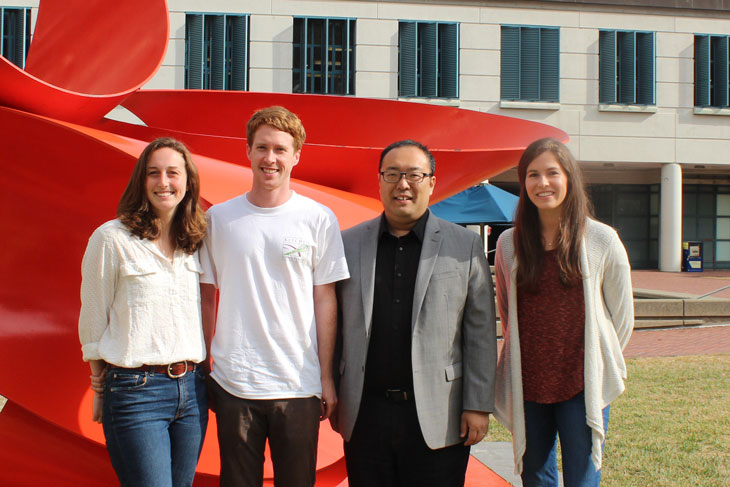Withania somnifera grows in dry pockets across India—Punjab, Gujarat, Kerala, and Rajasthan. Commonly known as Indian winter cherry, the fruiting plant has been cultivated for centuries for use in ayurvedic medicine and is known for its anti-inflammatory properties.

Professor Daniel Nomura co-authored the study with graduate students from his laboratory. Pictured left to right: Jessica Spradlin, Carl Ward, Dan Nomura, and Elizabeth Grossman.
Today UC Berkeley researchers published a study that identifies and maps how a natural chemical found in Indian winter cherry suppresses breast cancer cell growth. The study adds to a growing body of research that examines the effects of natural products on cancer cells in order to develop cancer treatments.
The paper was published Cell Chemical Biology by professor Daniel Nomura and researchers from the Departments of Nutritional Sciences & Toxicology, Chemistry, and Molecular & Cell Biology. The full study is available online, ahead of print publication on September 28.
Natural products have been a source of cancer treatments for decades: the drug paclitaxel was first isolated from Pacific yew tree bark in the 1970s and continues to be a common chemotherapy treatment today. While many other natural products exhibit anticancer activity, they are difficult to synthesize and isolate from their natural sources, a crucial step toward creating reliable therapeutics from natural chemicals.
To understand how the anticancer compound in Indian winter cherry functions, Nomura's lab employed chemical proteomic technologies to identify the protein targets of withaferin A, the active natural chemical found in the leaves of the plant. “Using a chemoproteomic technology called activity-based protein profiling (ABPP) enables us to identify natural product protein targets and even the binding pocket or ‘druggable hotspot’ within the protein target,” said Nomura.
Using this protein profiling technology, Nomura and his team studied how the compound targets proteins that impair breast cancer cell growth. They determined that withaferin A targets a regulatory subunit of a tumor suppressor called protein phosphatase 2A, which inactivates the protein kinase B and prevents breast cancer cells from proliferating. After identifying this druggable hotspot, Nomura’s team developed a covalent ligand—a synthetic molecule that binds to the same site as withaferin A—called JNS 1-40 to create the same anticancer activity in breast cancer cells.
The study was co-authored by graduate students, postdoctoral fellows, and research associates in the Nomura Research Group; these include co-first authors Elizabeth Grossman and Carl Ward, as well as Jessica Spradlin, Leslie Bateman, Tucker Huffman, David Miyamoto, and Jordan Kleinman.
The new research builds on a growing map of druggable hotspots that are being drawn within the field of proteomics, the study of proteins. “We use this general chemoproteomic technology to enable drug discovery against the "undruggable" proteome,” said Nomura. “Most protein targets in our cells are seemingly "undruggable" because they lack known pockets into which drug therapies can bind. This technology helps us develop cancer drugs that are much easier to make that have the same therapeutic action as their more complex natural products.”
The process of identifying protein targets of chemicals found in nature and creating a synthetic equivalent could help researchers develop drug therapies for cancer. “Isolating these natural products and understanding how to translate chemicals like withaferin A into drugs has been difficult,” said Nomura. “But the approach demonstrated in this paper will enable us to rapidly identify new cancer targets and cancer drugs.”
